Claude Monet
 From Conservapedia
From Conservapedia 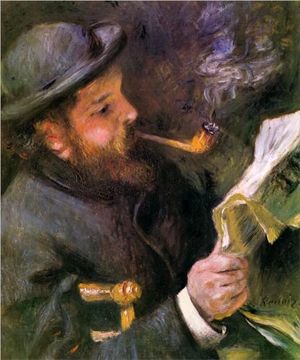
Claude Oscar Monet (1840–1926) was a French painter and the "founder of impressionism" who became known for his landscapes and for series of paintings showing changes under different aspects of light and atmosphere during different times of day and year. Some of the most well known of the series are "Water Lilies" and "Haystacks".
Monet may have become more Christian as he grew older, given that he painted images of the Crucifix and did multiple paintings of a church that were celebrated for their unique depiction of light.[1] Also, his best friend late in life was the priest at his local parish church in France, and his second wife was a devout Catholic.[1] Despite all this, Wikipedia prominently insists Monet was somehow an atheist without quoting any evidence in support.
His most valuable paintings are from his early period. His highest sales price for his work, Meules (1890), was $110.7 million in 2019.[2] His Le bassin aux nymphéas (1919) sold for $ 80.549 million, and the average sales price of Monet's works is $7.02 million.[3]
Contents
- 1 Childhood
- 2 Adulthood
- 3 Artistic career
- 4 Decline and Death
- 5 See also
- 6 External links
- 7 References
Childhood[edit]
Oscar-Claude Monet was born November 14, 1840, in Paris, France, the second son of Claude-Adolphe and Louise-Justine Aubrée Monet (a singer).[4] When he was five years old his family moved to the Normandy coastal town of Le Havre, where he spent his childhood. His father worked as a grocer and ship chandler. Monet's mother died in 1857 when he was 17 years old.[5] His widowed childless aunt, Marie-Jeanne Lecadre, took him into her home.
Adulthood[edit]
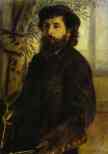
Monet first became known in Normandy for his charcoal caricatures. In 1856 at Le Havre, Monet met an artist named Eugene Boudin who encouraged him to paint outdoors, try oil paint and pastels, and make nature his subject. Claude Monet completed his first painting in 1858 entitled View from Rouelles. [6] Next year, Monet entered Atelier Suisse in Paris where he first studied painting. There he met Camille Pissarro and Gustave Courbet. In 1860 he spent two years in compulsory military service in Algiers, until he became ill and returned to France.[7] At Le Havre he met Johan Barthold Jongkind, who completed the training that Monet had already received from Boudin.
Artistic career[edit]
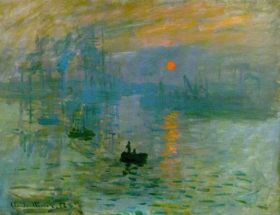
In 1862, he entered the studio of Charles Gleyre in Paris where he became friend with painters who would also become known as impressionists, Renoir, Sisley, and Jean-Frédéric Bazille. Leaving the studio of the famous Gleyre, he took a studio which he shared with Bazille. In 1869, Monet became the friend of Edouard Manet and joined him every evening in a café of the Batignolles, meeting also Paul Cezanne, and Degas.
In 1867 his first child, a son named Jean, was born to Monet and his girlfriend Camille-Léonie Doncieux. They were married 3 years later, in 1870. Between 1870 and 1871, Monet studied the works of John Constable and William Turner in London. There he met the art dealer Paul Durand-Ruel who later sponsored some of his exhibitions, and Pissarro. His second child, a son, Michel, was born in 1878. At that time Monet faced continuing financial difficulties and moved in with his former patron Ernest Hoschedé. Monet's wife Camille died of tuberculosis in 1879, and Monet and his children continued to live in the Hoschedé household.
Monet formed a group of artists in 1874 who called themselves the Société Anonyme des Artistes. Monet displayed his painting, "Impression, Sunrise", at the group's first exhibition, and the name impressionist was first used for his style of painting, and was applied to his group of painters as well, who became known as "impressionists".[8]
| “ |
Je suis à merveille pour peindre; c'est tout ce que l'on peut trouver de plus amusant, des maisons de toutes les couleurs, des moulins par centaines, des bateaux ravissants. |
” |
| “ |
I am marvellously well to paint; it is the funniest you can find, houses of all colors, mills by hundreds, delightful boats. |
” |
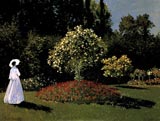
Monet worked in Argenteuil from 1872 to 1878. His famous Monet's Garden in Argenteuil (The Dahlias) was painted in 1873.
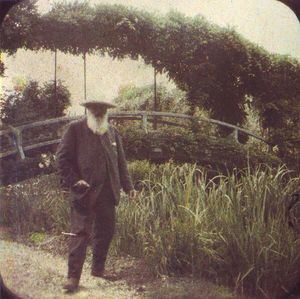
Monet continued to paint and his work became well known and popular, and by 1890, Monet had accumulated enough funds to buy his own house in Giverny, and added a water-lily garden and a Japanese bridge, that became the subject of several of his paintings (1906–26).
In 1892, after Ernest Hoschedé died, Monet and his widow Alice Hoschedé married.
Monet's Petite Gallery
Decline and Death[edit]
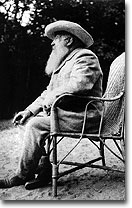
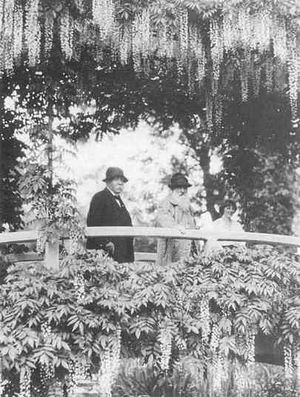
During his later years, Monet's vision declined, and over time he became almost blind, but still continued to paint.
In 1918 Monet decided to donate twelve large canvasses of "Waterlilies" to France. He finishes them in 1926 at the end of his life.
Claude Monet died in his house at Giverny on Dec. 5, 1926 at the age of 86. He was buried in his family grave at Giverny, in the presence of Georges Clémenceau. His famous home and garden with its waterlily pond and bridge at Giverny are a popular draw card for tourists. In the house there are many examples of Japanese woodcut prints on the walls.
His paintings are shown in large galleries including the Louvre, the Marmottan, the National Gallery in London, and in the United States, at the Art Institute of Chicago and the Metropolitan Museum of Art in New York City.
See also[edit]
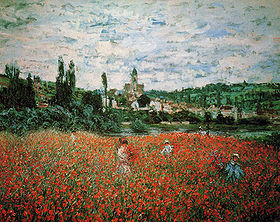
- Painting Schools
- Painting Masterpieces
- Francisco Goya
- Gallery of French Masterpieces
- French Still Life Painting
- The world’s most famous paintings

External links[edit]
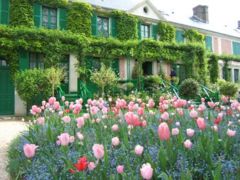
- Garden at Sainte-Adresse. Monet and Japan.
- Claude Monet in Venice.
- Claude Monet. Biography.
- Biography.
- Painting in Giverny. In Claude Monet's gardens.
- Claude Monet Paintings 1879-1886. by Debra N. Mancoff, PhD. (with many beautiful paintings).
- Claude Monet by himself.
- Biography of Claude MONET.
References[edit]
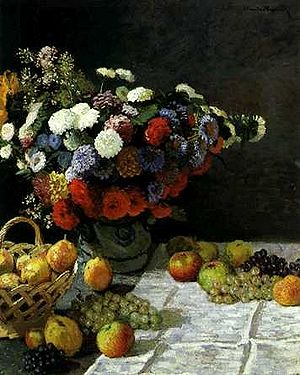
- ↑ 1.0 1.1 https://hollowverse.com/claude-monet/
- ↑ https://www.insider.com/most-expensive-items-sold-at-auction-in-the-past-decade-2019-11#claude-monets-meules-was-sold-for-1107-million-in-2019-17
- ↑ https://en.ivankrutoyarov.com/2013/02/the-most-expensive-paintings-by-claude.html
- ↑ http://www.guggenheimcollection.org/site/artist_bio_165.html
- ↑ http://www.myhero.com/myhero/hero.asp?hero=Monet_Selden_MS_05
- ↑ Claude Monet Biography and Monet Prints on Canvas Art Gallery.
- ↑ http://www.artofmonet.com
- ↑ http://academic.scranton.edu/student/KOSINSKIK2/Life.html


Categories: [French Painters] [Monet]
↧ Download as ZWI file | Last modified: 03/21/2023 22:54:39 | 26 views
☰ Source: https://www.conservapedia.com/Claude_Monet | License: CC BY-SA 3.0
 ZWI signed:
ZWI signed: KSF
KSF